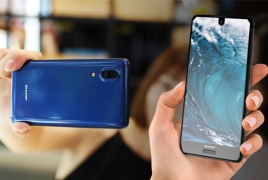
Sharp on Monday, August 7 unveiled its 29th edge-to-edge release dubbed AQUOS S2 which looks rather familiar. From afar, the S2's screen and the Essential Phone's screen share the same front-camera notch at the top, except the former is a smaller 5.5-inch panel with a slightly lower 2,040 x 1,080 resolution. The more notable difference here is how the corners at the top appear to be hastily trimmed, which is a bit of a letdown, but at least you're still getting a nice 135-percent sRGB gamut plus a handy 550-nit brightness, Engadget reports.
Thanks to Sharp's very own Free Form Display technology, the S2 has an impressive 87.5-percent screen-to-body ratio. It's also a much smaller device: a 5.5-inch display is tucked into the body of a conventional 4.9-inch smartphone. However, you still get a 3,030 mAh battery which is plentiful, especially considering that the phone is powered by Qualcomm's mid-range Snapdragon 660 (8x Kryo 260; 2.2GHz + 1.8GHz; 14nm) or Snapdragon 630 (8x ARM Cortex A53; 2.2GHz + 1.8GHz; 14nm), depending on which of the two price tiers you're going for.
While the S2 is no powerhouse, it comes equipped with a pair of nice cameras. The front imager has an 8-megapixel 1.4um sensor with f/2.0 aperture, which is pretty good given how compact the module is. The f/1.75 dual camera on the back consists of a 12-megapixel sensor plus an 8-megapixel sensor, both also feature efficient 1.4um pixels and together offer a seven-level bokeh effect.
Compared to previous Sharp smartphones, the S2 has ditched the old bone conduction actuator in favor of a conventional earpiece that's hidden underneath the screen, next to the front camera, with its audio channeled to a thin pipe placed along the top edge of the screen for clearer sound. While the front camera is no longer placed on the chin, there's now a fingerprint reader centered there -- an interesting choice when both the Essential Phone and Xiaomi's Mi Mix opted for a rear fingerprint reader instead.

